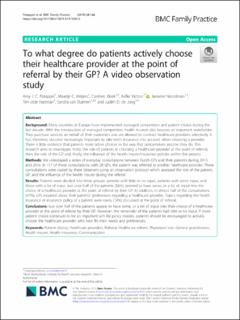| dc.contributor.author | Potappel, Amy J. C. | |
| dc.contributor.author | Meijers, Maartje C. | |
| dc.contributor.author | Kloek, Corelien | |
| dc.contributor.author | Victoor, Aafke | |
| dc.contributor.author | Noordman, Janneke | |
| dc.contributor.author | Olde Hartman, Tim | |
| dc.contributor.author | van Dulmen, Sandra | |
| dc.contributor.author | de Jong, Judith D. | |
| dc.date.accessioned | 2020-03-16T13:47:45Z | |
| dc.date.available | 2020-03-16T13:47:45Z | |
| dc.date.created | 2020-02-13T18:29:59Z | |
| dc.date.issued | 2019 | |
| dc.identifier.citation | BMC Family Practice. 2019, 20 (1), 1-10. | en_US |
| dc.identifier.issn | 1471-2296 | |
| dc.identifier.uri | https://hdl.handle.net/11250/2647018 | |
| dc.description | This article is distributed under the terms of the Creative Commons Attribution 4.0 International License which permits unrestricted use, distribution, and reproduction in any medium, provided you give appropriate credit to the original author(s) and the source, provide a link to the Creative Commons license, and indicate if changes were made. | en_US |
| dc.description.abstract | Background:Many countries in Europe have implemented managed competition and patient choice during thelast decade. With the introduction of managed competition, health insurers also became an important stakeholder.They purchase services on behalf of their customers and are allowed to contract healthcare providers selectively. Ithas, therefore, become increasingly important to take one’s insurance into account when choosing a provider.There is little evidence that patients make active choices in the way that policymakers assume they do. Thisresearch aims to investigate, firstly, the role of patients in choosing a healthcare provider at the point of referral,then the role of the GP and, finally, the influence of the health insurer/insurance policies within this process.Methods:We videotaped a series of everyday consultations between Dutch GPs and their patients during 2015and 2016. In 117 of these consultations, with 28 GPs, the patient was referred to another healthcare provider. Theseconsultations were coded by three observers using an observation protocol which assessed the role of the patient,GP, and the influence of the health insurer during the referral.Results:Patients were divided into three groups: patients with little or no input, patients with some input, andthose with a lot of input. Just over half of the patients (56%) seemed to have some, or a lot of, input into thechoice of a healthcare provider at the point of referral by their GP. In addition, in almost half of the consultations(47%), GPs inquired about their patients’preferences regarding a healthcare provider. Topics regarding the healthinsurance or insurance policy of a patient were rarely (14%) discussed at the point of referral.Conclusions:Just over half of the patients appear to have some, or a lot of, input into their choice of a healthcareprovider at the point of referral by their GP. However, the remainder of the patients had little or no input. If morepatient choice continues to be an important aim for policy makers, patients should be encouraged to activelychoose the healthcare provider who best fits their needs and preferences. | en_US |
| dc.language.iso | eng | en_US |
| dc.rights | Navngivelse 4.0 Internasjonal | * |
| dc.rights.uri | http://creativecommons.org/licenses/by/4.0/deed.no | * |
| dc.title | To what degree do patients actively choose their healthcare provider at the point of referral by their GP? A video observation study | en_US |
| dc.type | Peer reviewed | en_US |
| dc.type | Journal article | en_US |
| dc.description.version | publishedVersion | en_US |
| dc.rights.holder | © The Author(s). 2019 Open Access | en_US |
| dc.source.pagenumber | 1-10 | en_US |
| dc.source.volume | 20 | en_US |
| dc.source.journal | BMC Family Practice | en_US |
| dc.source.issue | 1 | en_US |
| dc.identifier.doi | 10.1186/s12875-019-1060-2 | |
| dc.identifier.cristin | 1794015 | |
| cristin.ispublished | true | |
| cristin.fulltext | original | |
| cristin.qualitycode | 1 | |

